What is the importance of cat cognition? A cat’s senses become essential to survival from very early in their lives. Cats detect stimuli through sight, hearing, scent, and smell, and by the presence of an array of whiskers. These stimuli prove essential for a young kitten and continue to provide vital information that allows the cat to grow and thrive as an adult.
Cats focus these senses to figure out their relationship to their mother. Also, these innate senses will help them to detect predators, and such protection continues throughout their lives.
Aspects Of Cat Cognition
By far the most critical aspect needed to understanding cat cognition centers on a highly deveped sense of smell. They also use other senses to allow them to perceive their environment in a variety of ways. Through hearing, smelling, seeing, and using their whiskers to detect stimuli, they have a heightened sense of their environment.

Consider these finely tuned abilities of cats: Because they have a great memory, they can keep an object in mind even when it goes out of sight. This skill might explain why they have such great talent at hunting.
An example: Mocha, my cat, loves his little spring toys, but forever loses them under some piece of furniture. Yet he remembers their location, and often returns to the spot and looks underneath or tries to get his paw under there far enough to snag the lost object.
Here’s a fact you may not know: Did you know a cat can learn to understand the difference between quantities, such as knowing the difference between two dots and three dots?
Early Experience Can Determine Social Cognition
Though social cognition often comes into question, as people tend to think cats are solitary, it depends on what they learn in the early weeks of their lives. If they live among people and have positive attention from humans, they learn friendliness. Also, both feral and domestic cats build relationships with cats in their vicinity.
Mocha started as a feral. However, I observed him recently when he established a friendship with a strange cat in our neighborhood, and the two went hunting together.
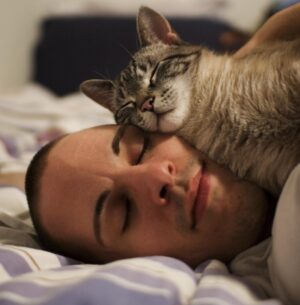
The truth: Cats become exceptionally socially cognitive as long as their experience allows them such a chance.
Cats are able to take their predatory instincts and apply them to daily life. Very possibly, they prove much greater at sensing danger, detecting movement, and understanding their senses, with results far superior to what we learn early on as humans.
Their sensory talents allow them to perceive their environment in different ways than we can do as humans. Let’s look at the cat’s senses and how they use them.
Smell
A cat’s sense of smell ranks far superior to ours and remains one of the most important ways he receives feedback from his environment. His smell helps him communicate with others and allows him to assess potential risks and pleasures.

The cat has 200 million odor-sensing cells in that nose as compared to about 5 million in humans.
A cat can detect the presence of other cats even when they remain outside your door. He can ID strange animals you’ve contacted just by smelling your clothing. He drops his own odor to mark both territory and important objects in his environment.
Sight
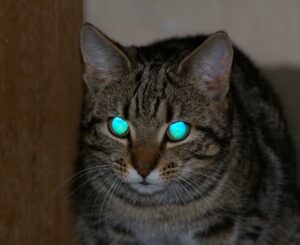
Kitty needs only 1/5 the light intensity that we do to make things out at night. However, he cannot see in total darkness.
Those glowing cat eyes you see at night come from a layer of cells just behind the retina at the back of the eyes . This layer we call the “tapedum lucidum”. With this layer, he can see form and movement even when very little light intensity prevails.
Though his abililty to distinguish separate objects, called visual acuity, registers at only 1/10 of our own, he can detect movement at a much faster rate than we can.
Hearing
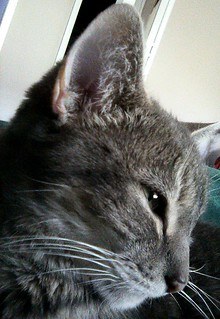
Those flexible ears atop his head can rotate to pick up sounds that are then funneled to the brain. His ears move back and forth as he listens; with this movement he has an exceptional ability to pinpoint the source of the sound.
His upper range of hearing measures about 60-65 kilohertz (kilocycles per second). This hearing acuity allows a mature cat to hear her kittens as well as the ultrasonic vocalizations and sounds of small rodents.
Humans can hear sounds up to about 8.5 octaves, while a cat hears about 10. This hearing sense in cats explains why certain types of music can agitate him.
His hearing does have its limitations. He can hear about 5 degrees of separation to distinguish between two different tones, where humans can differentiate sounds 0.5 degrees apart.
Touch
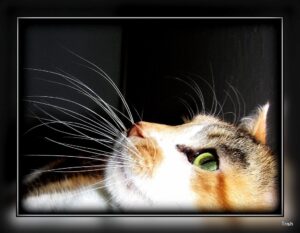
As with humans, a cat’s sense of touch encompasses his entire body. He does have a very special collection of whiskers (vibrissae) on his cheeks, lips, and above his eyebrows. These whiskers become like very sensitive fingers, which can detect objects with great accuracy.
They help a cat to navigate on a hunt in low light. Please, never cut your cat’s whiskers, as it would serve the same purpose as taking away a blind person’s cane.
Because his body has such sensitivity to touch, when you stroke or pet your cat, you invoke certain physical and emotional responses. His heartbeat slows and his body relaxes. He starts to purr, and enters a euphoric state. It’s a tactilely-induced state and becomes the human way of telling the cat, “You are mine.”
Taste
The cat’s ability to differentiate tastes does not match that of the human. Where we have about 9,000 taste buds on our tongue, the cat has only 473. These taste buds take the form of mushroom-shaped papillae at the top and sides of the tongue. Cup-shaped papillae form at the back of the tongue. His sense of smell has more importance in his decision as to whether a food might prove tasty.
The taste buds respond to flavor, texture, and temperature. He does not care for food below room temperature. This preference stems from a survival instinct: He has a preference for recently-killed prey rather than when stone-cold.
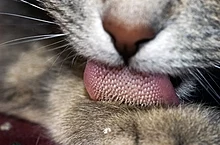
Right before bedtime I give Mocha two medium-to-small servings of food. One, his kibble, he gobbles up immediately. The other serving comes from a can I just took from the refrigerator.
Because of the cooler temperature, he has no interest in the second serving at the time, but in the middle of the night, it’s warmed to room temperature. Then he eats it. I’ve found it keeps him from yowling at around 4:00 because he wants food. Whatever works!
The Cognitive Sense And Square Shapes
The cognitive sense explains partly why cats like to sit in small boxes. It’s in part attributed to the cat’s feeling of safety when squeezed into a small space. It might also reflect the feline visual perception.
A study was done by Gabriella Smith, produced as a follow-up to a study done in 2017, in which cat owners on Twitter showed pictures of their cats sitting inside squares marked on the floor with tape, a kind of virtual box.
Ms. Smth, a graduate student at Hunter College (CUNY). used, in part, a Kanuzsa square, developed by Italian psychologist and artist, Gaetano Kanuzsa. He was interested in illusory (subjective) centers that visually evoked an edge in the brain when there was none.

The earlier study took place in a lab. Smith wanted to reproduce the study in the cat’s home. That 2017 study, concluded that, yes, cats become susceptible to this illusion. How would a cat react in his natural environment?
The Kanuzsa square, by the way, receives its form when four Pac Man figures become positioned with the Pac Man mouths facing inward, to create the four corners of a square.
Smith recruited her cat owners from Twitter. Unfortunately, though 500 people responded to her request, only 30 completed the experiment. It would prove interesting to know results from a larger number of people and cats.
For this experiment, the owner first marked the Kanuzsa square on the floor with paper cut-outs. Also, he/she taped other square shapes on the floor. They were put in place before the cat entered the room.
When the cat came into the room, the owner videotaped the results. If the cat sat or stood with all legs inside the square within five minutes, the owner stopped recording and noted the cat’s compliance.
Of the 30 cats who participated in the experiment, 9 of them stood within one of the squares for at least 3 seconds. They chose the Kanuzsa illustration just as often as the regular square. What would have happened if all 500 cats could have completed the test?
The conclusion: The presence of shapes taped on the floor drew the cats in the same way as they might have gravitated to a real box. Their sensitivity to the shape, even though not a form with sides, seemed to prevail
A Cat’s Perception Of Time
What about time? What can we learn about a cat’s perception of this concept?
Unlike humans, who see time with a linear perception, cats experience time in a more fluid and elastic manner. Because they have the ability to focus on the present moment, they can fully immerse themselves in their surroundings.
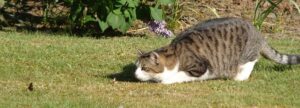
This ability helps make them excellent predators. As they stalk prey, they observe and analyze every movement and sound. In this manner, time stops for them.
Because their internal clock helps them analyze events and establish routines, they know when it’s time for meals or when their human heads off or returns from work. They like predictability and adhere to a daily schedule.
When I lived in Bell’s Flats and had a shop in Kodiak, Carlos knew I’d return home at about 7:30 p.m. He almost always sat on the front steps of the house at that time so he could greet me on my arrival.
Though a cat may not have the same concept of time as a human, he does have memory that allows recall of past experiences. He can remember a comfortable nap spot, for example, or where a food stash hides. Because of this memory, he can navigate through his environment and make informed decisions.
Navigational Skills Add To His Cognitive Abilities
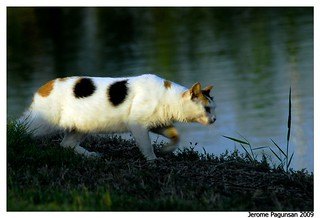
If a cat wanders far from home, he finds his way back with no problem. He has a strong spatial awareness and an impressive ability to navigate. He relies on landmarks, scents, and visual cues to create mental maps of where he goes and how he returns.
This ability to live in the present, remember past experiences, and navigate through his surroundings with precision marks him as having a remarkable adaptability and intelligence.
Cats, like humans, have internal body clocks that regulate their daily activities. If we create for them a stimulating and engaging environment, we can help them maintain a healthy sense of time and their place in the world.
References I used for this post:
petsmont.com/blogs/pets/what-does-your-cat-really-think-of-you petplace.com/article/cats/pet-behavior-training/understanding-your-cats-senses getpocket.com/explore/item/what-cats-love-of-boxes-and-squares-can-tell-us-about-their-visual-perception https://www.msn.com/en-us/health/wellness/understanding-the-time-perception-of-cats-do-they-have-a-sense-of-time/ar-AA1hAEwr

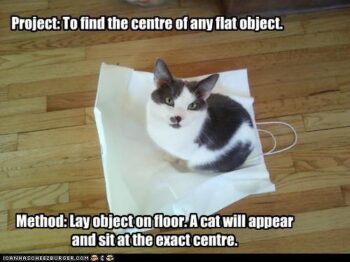
As usual, I enjoy learning from your articles. Thank you.
Carole, I thank you. As you can see, you contributed to this post by sending me the articles you have found about cats. I appreciate that. Glad you liked the end result.